The Commission published its Communication on the European Green Deal in mid-December 2019. Previously flagged in Commission President von der Leyen’s Political Guidelines for the new Commission, it defines the key political objectives of the new Commission for the next five years.
The headline commitment is to make Europe the first climate-neutral continent by 2050 (while conflating the EU with Europe may seem like over-reach by the Commission, it should be remembered that other European countries, most recently Switzerland, either participate in or are linked to the EU Emissions Trading Scheme and the UK government’s preference is that it will remain associated after Brexit).
But the Green Deal goes well beyond just climate policy and is intended to address environmental sustainability issues more broadly, including the protection of natural resources and the minimisation of resource use. The broad scope of the Green Deal is illustrated in the diagram below taken from the Commission Communication.
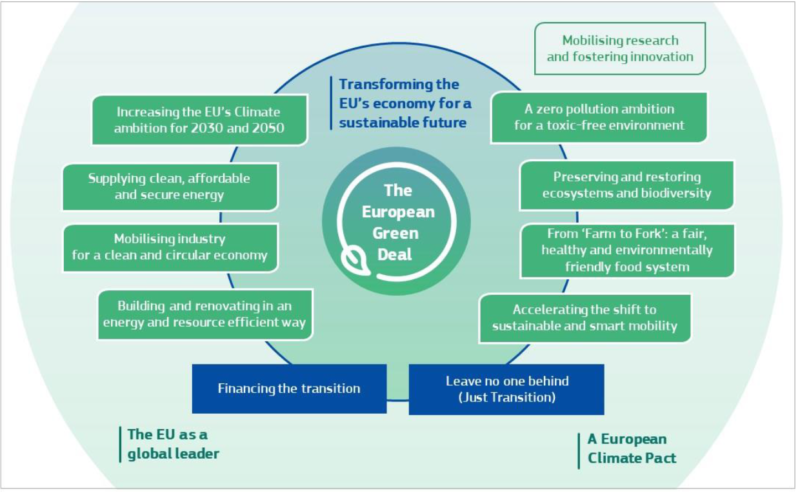
Elements of the European Green Deal
The European Green Deal is advertised as Europe’s new growth strategy. It aims to transform the EU into a resource-efficient and competitive economy where there are no net emissions of greenhouse gases in 2050 and where economic growth is decoupled from resource use.
The Commission recognises that new technologies and disruptive innovation are critical to achieve the objectives of the European Green Deal. Horizon Europe is expected to play a pivotal role in leveraging additional public and private investment in research. At least 35% of its budget will fund new solutions for climate which are relevant for implementing the Green Deal.
This is a poke in the eye of those environmental groups that believe that ‘degrowth’ is necessary to stay within planetary boundaries and who call for a sharp cut in living standards to achieve this. But the Commission is right to emphasise that decarbonisation and growth must go hand in hand. The destruction of wealth and the scale of job losses involved in the green transition will only be acceptable if there is sufficient economic progress to open alternative opportunities for those displaced.
For some economists, the considerable additional investment required to decarbonise the economy could act as a needed stimulus for the European economy and help to stave off the next recession (for example, this blog post by Jean Pisani-Ferry on the Peterson Institute of International Economics website). The very low, in some countries negative, interest rate environment makes it attractive to front-load investment by issuing debt. Both public and private investment will be required although private investment will have to do most of the heavy lifting, and the question is what can trigger this?
The Commission will later this week launch a Sustainable Europe Investment Plan to support one trillion euro of investment over the next decade. The intention is to increase funding for the green transition in various ways. At least 25% of the EU’s long-term budget should be dedicated to climate action. The European Investment Bank, Europe’s climate bank, will provide further support by doubling the share of its total financing (currently 25%) dedicated to climate investment by 2025. Additional private funding will be leveraged using the EU’s budget guarantee, with the InvestEU Fund expected to leverage €280 billion of private and public investment in the coming decade. For the private sector to contribute to financing the green transition, the Commission will present a Green Financing Strategy in 2020.
Pisani-Ferry notes that these measures will not be enough to induce green capital expenditures in the absence of a high, credible, long-term carbon price that puts a monetary value on reducing emissions. The European Green Deal needs a far higher price of carbon. What this price should be in 2030 can be debated. It is certainly encouraging that recent reforms of the Emissions Trading System have led to a sharp increase in the price of allowances for the 45% of emissions covered by the ETS. However, few governments have had the political courage to price carbon adequately in the non-ETS sector and some of those that have tried, such as France, have quickly back-tracked in the face of popular protests.
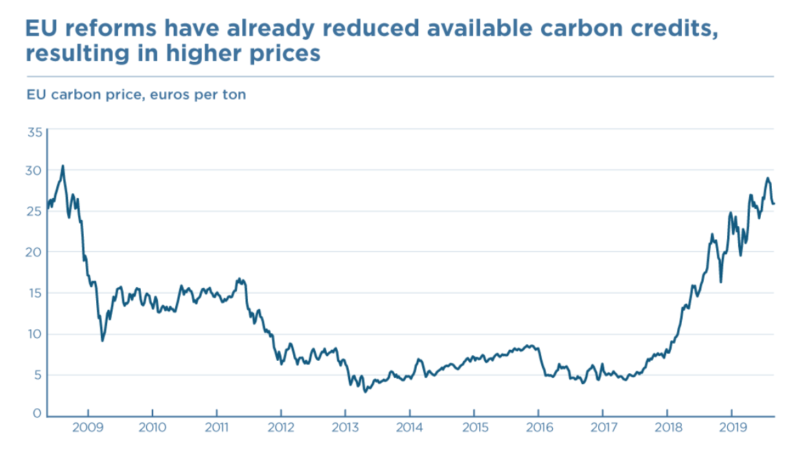
Hence the importance of the European Climate Law that the Commission intends to propose in March to enshrine the 2050 climate-neutrality target into law. According to the Commission Roadmap for the Climate Law it intends to transform the way EU policies are made and to set the long-term direction of travel for meeting the 2050 climate-neutrality objective through all policies, in a socially-fair and cost-efficient manner. It will aim to ensure that all EU policies contribute to the climate-neutrality objective and that all sectors play their part. By summer 2020, the Commission will present an impact-assessed plan to increase the EU’s greenhouse gas emission reductions target for 2030 to at least 50% and towards 55% compared with 1990 levels in a responsible way (36 to 43% reduction with respect to 2017, see diagram).
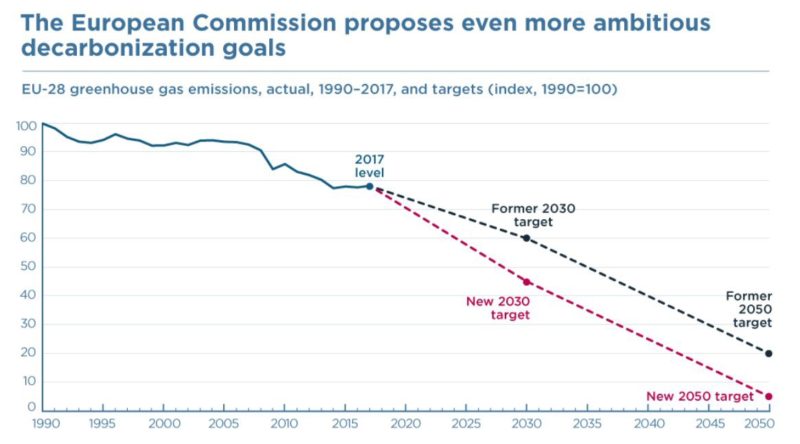
To deliver these additional greenhouse gas emissions reductions, the Commission will, by June 2021, review and propose to revise where necessary, all relevant climate-related policy instruments. Part of this plan will be to further reform the Emissions Trading System to include more sectors, with buildings, transport and the maritime sector specifically mentioned. Member State targets to reduce emissions in sectors outside the Emissions Trading System will be re-examined, and the regulation on land use, land use change and forestry will be reviewed. These policy reforms should help to ensure effective carbon pricing throughout the economy.
The Commission’s climate ambitions will cause significant economic dislocation. The transition to a carbon-neutral economy will destroy jobs in extractive, energy-producing, and manufacturing industries. Decarbonisation will reduce the value of brown assets (from coal mines and oil fields to energy-inefficient housing). At the same time, it will require investing in new processes and technologies because the pricing of carbon will encourage new investment in energy efficiency and renewable energy and create jobs in the service sector. It will therefore involve significant reallocation of labour across industries.
The Commission recognises that the green transition can succeed only if it is conducted in a fair and inclusive way. It therefore proposes a Just Transition Mechanism, including a Just Transition Fund, as part of the Sustainable Europe Investment Plan, to ensure no one is left behind. This will focus on the regions and sectors that are adversely affected by the transition because they depend on fossil fuels or carbon-intensive processes.
Support will be linked to promoting a transition towards low-carbon and climate-resilient activities. It will also strive to protect the citizens and workers most vulnerable to the transition, providing access to re-skilling programmes, jobs in new economic sectors, or energy-efficient housing. It will draw on sources of funding from the EU budget as well as the EIB group to leverage the necessary private and public resources. For selected sectors exposed to international competition, the Commission intends to propose a border carbon adjustment mechanism to reduce the risk of carbon leakage.
The Just Transition Mechanism is intended to provide targeted support to help mobilise over €100 billion for the affected regions. It will have three elements: a Just Transition Fund of €7.5 billion from the EU budget managed under Cohesion Fund rules with a requirement for national co-financing using Cohesion Fund resources and additional national financing to provide between €30-50 billion of financing; a dedicated just transition scheme under InvestEU to mobilise up to €45 billion of investments; and a public sector loan facility with the European Investment Bank backed by the EU budget to mobilise between €25 and €30 billion of investments.
Cohesion Fund recipients express concern that, unless there is a further increase in the overall EU budget beyond the Commission’s draft MFF proposal, this could simply represent a reshuffling of existing Cohesion Fund resources.
The just transition mechanism will be supported by a European Climate Pact to be launched in March 2020 – bringing together regions, local communities, civil society, industry and schools. Together they will design and commit to a set of pledges to bring about a change in behaviour, from the individual to the largest multinational. This recognises the importance of the involvement and commitment of the public and all stakeholders to the success of the European Green Deal.
Farm to Fork Strategy
Farming and food systems will have a major part to play in delivering the European Green Deal. A new Farm to Fork Strategy will prepare a roadmap towards a fair, healthy and environmentally-friendly food system. It reflects an apparent seismic shift in the framing of agricultural and food policy within the Commission over the past two years in the wake of damning reports from the International Panel on Climate Change (on the climate emergency), the Intergovernmental Science Policy Platform on Biodiversity and Ecosystem Services (on the collapse in biodiversity) as well as the European Environment Agency’s State and Outlook Report on the European Environment 2020 (which, despite progress in some areas, noted that Europe is not on track to meet policy objectives and targets in many areas set out in the 7th Environmental Action Programme).
The Commission’s White Paper on the future of farm and food policy in November 2017 which set out the rationale for the current update of the CAP post 2020 now seems to belong to another age.
True, it recommended that the CAP needed to pursue higher environmental and climate ambition in the light of the Paris Agreement and the UN Sustainable Development Goals but this was couched as a further evolution of existing farm practices and farm policy.
Much sharper language is now used in the Commission’s justification for its Farm and Food Strategy:
Food production results in air, water and soil pollution, contributes to the loss of biodiversity, climate change and resource depletion. Food waste is at an unacceptable level… Obesity is also a growing concern with over half the EU’s adult population is now overweight, contributing to a high prevalence of diet-related diseases and related health care costs. The European Union has committed to lead on the Sustainable Development Goals, however major changes are needed for us to be able to deliver. It is clear: a new, healthier, fairer and more sustainable approach to food systems is needed. Business as usual is no longer an option.
The Commissioner for Health and Food Safety Stella Kyriakides bluntly repeated this message in her speech at the annual DG AGRI Outlook conference last December.
Today’s Europe is facing some uncomfortable truths. The population is growing, yet natural resources are shrinking and biodiversity is disappearing. Millions of citizens live in food poverty, yet we waste a fifth of the food we produce, and half the adult population is overweight.
We have committed to lead on the Sustainable Development Goals, but we cannot deliver without implementing major change. It is clear: a new, healthier, fairer and more sustainable approach to food systems is needed. Business as usual is no longer an option when it comes to food production.
This goes for producers as well as for consumers.
The Farm to Fork strategy for Sustainable food is a key component of the European Green Deal. European food is famous for being safe, nutritious and of high quality. It should now also become the global standard for sustainability.
This step-change in thinking within the Commission is the product of a number of factors: the mounting evidence of environmental damage with potentially catastrophic consequences if left unchecked, as spelled out in the reports cited earlier; the results of the European Parliament elections in May 2019 which saw an increase in support for green parties and which had a significant influence on the way Commission President von der Leyen formulated her Political Guidelines (even if, in the end, these parties did not vote for her election); and the dilution of the sole power of DG AGRI to determine farm policy, a process that had begun under previous Commissions but which will be accelerated by the new working structure of the Commission (see diagram below).
The farm unions do not yet appear to have grasped the extent to which the fundamentals of the farm policy debate have shifted in the past two years. Their response to the damning indictment of the impact of current farming practices in the reports quoted above has been to complain of agri-bashing and that farmers are being unfairly blamed!
Indeed, individual farmers must work within a market and policy system that has failed to properly reflect sustainability issues and can hardly be blamed for doing the best they can within that system. The Commission’s Farm to Fork Strategy has now recognised that this system is no longer fit for purpose. Fortunately, there are also those within the farming sector, both individual farmers but also sectors such as the dairy industry, that also share this view.
The Farm to Fork strategy will have six principal objectives which feed into and are in turn influenced by other strategic objectives of the European Green Deal:
- To contribute to Europe’s climate change agenda
- To protect the environment (linking to the Zero Pollution Strategy and the Circular Economy Strategy)
- To preserve biodiversity (contributing to the updated Biodiversity Strategy for 2030)
- To encourage sustainable food consumption
- To promote affordable and healthy food for all
- To improve farmers’ position in the value chain.
We have some inkling of what might be proposed to address these objectives in the Mission Letters provided by Commission President von der Leyen to the various incoming Commissioners (see figure below). In agricultural policy, the Agriculture Commissioner is encouraged to seek a swift agreement on the CAP post 2020 that should be ambitious both in terms of food security and environmental and climate objectives. He is asked to focus specifically on healthier and more sustainable food production, including through organic production.
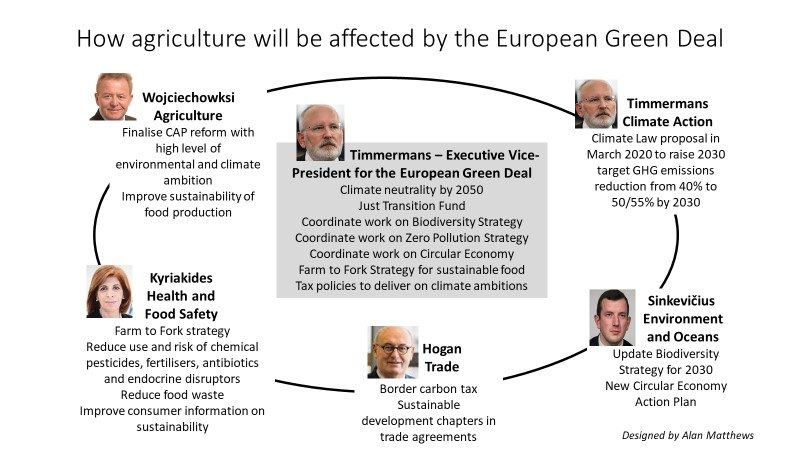
The Commissioner for Health and Food Safety will lead on the Farm to Fork Strategy covering every step in the food chain from production to consumption. She is asked to reduce the use of chemical pesticides, fertiliser and antimicrobials as well as to reduce the exposure of citizens to endocrine disruptors as part of delivering on the zero-pollution ambition. Another of her responsibilities will be to contribute to the circular economy by reducing the environmental impact of the food processing and retail sectors by acting on transport, storage, packaging and food waste. She will also stimulate sustainable food consumption and promote affordable healthy food for all by improving consumer information, notably by looking at ways to address demands for more visible and complete information on the health and sustainability of food products.
The Environment Commissioner has two major tasks relevant to agriculture. He will lead on the zero-pollution ambition with responsibility for reducing air, water and noise pollution from agriculture and food production, as well as putting forward a new Biodiversity Strategy for 2030. His work on the Circular Economy Action Plan designed to ensure sustainable resource use particularly in resource-intensive sectors may also have implications for the agricultural sector.
The Climate Action Commissioner will have responsibility for proposing the EU’s Climate Law in March 2020 that will enshrine the EU objective of climate neutrality objective by 2050 in legislation. The Commissioner will also present by summer 2020 an impact-assessed plan to increase the EU’s greenhouse gas emission reductions target for 2030 to at least 50% and towards 55% compared with 1990 levels in a responsible way.
Finally, the Trade Commissioner has two responsibilities of potential relevance to future agricultural policy. One is the task to contribute to the design and introduction of a border carbon tax working closely with the Commissioner for the Economy. While agriculture is not likely to be among the first industries covered by this tax, it may have relevance if market-based instruments (such as an emissions tax or inclusion of agriculture in the Emissions Trading Scheme) were extended to agriculture as part of a more ambitious climate package. The Trade Commissioner will also be responsible for negotiating and enforcing the sustainable development chapters in trade agreements.
Overseeing the whole will be Frans Timmermans who, as well as being Climate Action Commissioner, is also the Executive Vice-President in charge of the European Green Deal.
Many open questions
The Commission will present the Farm to Fork Strategy later this spring with a view to launching a broad stakeholder debate covering all the stages of the food chain and paving the way to formulating a more sustainable food policy. What the implications for agriculture will be when these various inputs are brought together under the responsibility of the Executive Vice-President for the European Green Deal and the Commissioner for Health and Food Safety (and not the Commissioner for Agriculture) remain to be seen.
Although the Commission has spelled out its intentions with respect to the Strategy in some detail, many open questions remain and will only be resolved in the months ahead. A shortlist of the most important questions would include the following (for a more comprehensive and detailed list, see this open letter from various civil society organisations to Executive Vice-President Timmermans) .
How will the European Green Deal be reflected in the MFF outcome for 2021-2027? The MFF negotiations were already underway on the basis of the Commission’s May 2018 draft proposa by the time the new Commission launched its Green Deal in December 2019. These negotiations have been bogged down in divisions between net contributor and net recipient Member States. The European Green Deal envisages significant additional expenditure to achieve the climate neutrality goal by 2050, notably for the Just Transition Fund for which no provision was made in the Commission’s MFF proposal. Poland specifically refused to sign up to the European Council conclusions in December 2019 endorsing the objective of a climate-neutral EU by 2050 because of the absence of assurances that Transition Fund money would be additional to the cohesion fund money it would already receive. Uncertainty around the future CAP budget also remains to be resolved.
How will the Farm to Fork strategy be reflected in the post-2020 CAP legislation? There is an awkward misalignment of timing between the ongoing negotiations on the Commission’s draft legislative proposals for the CAP post 2020 and integrating the findings of the Farm to Fork Strategy. The broad stakeholder debate paving the way to formulating a more sustainable food strategy will only be triggered in Spring 2020 and proposals for legislative change may only emerge later in the year when the CAP legislation may well be agreed.
Regulatory initiatives, such as those to significantly reduce the use and risk of chemical pesticides, as well as the use of fertilisers and antibiotics, are anticipated in 2021 and are independent of the cycle of CAP reform. Here the main focus will be on the scope of any specific reduction targets that are included.
Any moves to promote a more sustainable agriculture will have to be scheduled and funded as part of the post-2020 CAP legislation now being debated by the co-legislature. The Commission decided to support the draft legislation proposed by the previous Commission. It proposes instead that the draft CAP Strategic Plans to be prepared by Member States under this draft legislation would be examined by the Commission with reference to the ambitions of the European Green Deal and the Farm to Fork Strategy. As stated in the Green Deal Communication:
Given that the start of the revised Common Agricultural Policy is likely to be delayed to the beginning of 2022, the Commission will work with the Member States and stakeholders to ensure that from the outset the national strategic plans for agriculture fully reflect the ambition of the Green Deal and the Farm to Fork Strategy. The Commission will ensure that these strategic plans are assessed against robust climate and environmental criteria. These plans should lead to the use of sustainable practices, such as precision agriculture, organic farming, agro-ecology, agro-forestry and stricter animal welfare standards. By shifting the focus from compliance to performance, measures such as eco-schemes should reward farmers for improved environmental and climate performance, including managing and storing carbon in the soil.
While this sounds fine in principle, major questions remain whether amendments to the Commission’s draft legislation by the co-legislature will remove some of the tools and instruments foreseen to drive the green transition in farming, and whether the proposed governance arrangements are sufficiently robust to enable the Commission to ensure that Strategic Plans fully reflect the ambitions of the Farm to Fork Strategy.
What will be agriculture’s role in the transition to climate neutrality? The Farm and Food Strategy is intended, among other things, to strengthen the efforts of European farmers to tackle climate change but the Commission Communication is not very forthcoming on how this might be done. An important contribution of the Strategy should be to clarify the contribution expected from the farming and food sector and to make more concrete the roadmap to deliver this contribution.
The main policy instrument highlighted in the Communication is the requirement that at least 40% of the common agricultural policy’s overall budget should contribute to climate action. It says it will work with the European Parliament and the Council to achieve at least this level of ambition in the proposals. If the Commission wants its Farm and Food Strategy to have a minimum of credibility, it should immediately seek the agreement of the co-legislature to revise the basis for this calculation which is set out in Article 87 of the CAP Strategic Plan draft regulation.
The weightings set out in this Article bear no relationship to the real climate impact of the different CAP measures, as has been pointed out by the European Court of Auditors. This type of greenwashing, obvious to everyone, simply undermines the Commission’s credibility and the force of its argument that business as usual is no longer an option. As the Court has pointed out, the use of these weightings in the current period has meant that there was no significant shift in CAP funds towards climate action. Before the process of approving the Strategic Plans, the Commission should come forward with revised weightings based on better indicators of the actual climate impact of the different CAP measures and seek agreement on amending the draft Regulation to incorporate these improvements.
Agricultural emissions are not expected to be reduced to zero in the various pathways to net zero examined in the Commission’s 2018 Communication A Clean Planet for All, but it remains an open question whether some specific reduction targets at EU level should be set. The way in which emissions and removals in the LJULUCF sector are integrated into reduction targets may need to be reviewed when these targets are increased.
Agriculture is specifically not mentioned as one of the sectors that might be integrated into the ETS, leaving open whether the Commission sees a role for market-based instruments in reducing these emissions. The extent to which the non-CO2 agricultural emissions of nitrous oxide and methane can be reduced by efficiency improvements or technological options, or may require reductions in activity levels, specifically livestock numbers, should be examined. The role of greenhouse gas metrics, considering the specific characteristics of methane as a short-lived gas in the atmosphere, should be evaluated. The potential for diet changes, technological innovations in developing alternative proteins and reductions in food waste to drive emissions reduction along the food chain should be assessed.
How will the just transition principle apply to agriculture? The previous analysis pointed out that implementing the European Green Deal is bound to be disruptive, leading to job losses in some sectors that will disappear but also promising new opportunities in the green sectors that will emerge in the transition. Such disruption can also occur within sectors, such as agriculture. One of the reasons why developing a climate roadmap for agriculture at the EU level is a good idea is that it would help to identify the likely scale of the changes expected and where disruption might occur. Whether agricultural regions that may be adversely affected will be eligible for assistance from the Just Transition Fund is another important question for the future.
This post was written by Alan Matthews
Update 15 January 2020: The paragraph on the Just Transition Mechanism was updated to incorporate further details made availabe in the Commission’s announcement of the Mechanism the previous day.
Picture credit: Ben_Kerckx

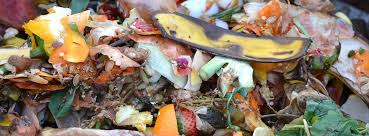

The challenges facing rural and farming are ;
Income reduction and the threat to farm families
The impact on family farms of the green deal in terms of higher costs associated with higher investment.
The low supports for biodiversity measures suitable for family farming
Generational renewal. This a crisis in terms of new people entering agriculture.
The lack of broadband in rural areas is a real disadvantage to improving the digital involvement.
@Seamus
Thanks for the comment and for identifying key challenges facing farming. The agricultural elements in the Green Deal (the Farm to Fork Strategy) emphasise the need to give greater priority to the environmental and public health challenges, these cannot be ignored. The future CAP Strategic Plans will need to set out a clear set of priorities and sense of direction to navigate through these sometimes competing agendas.